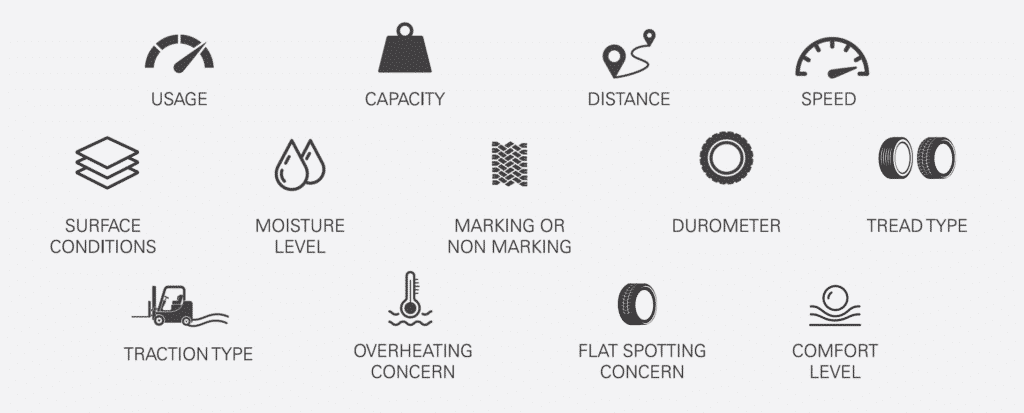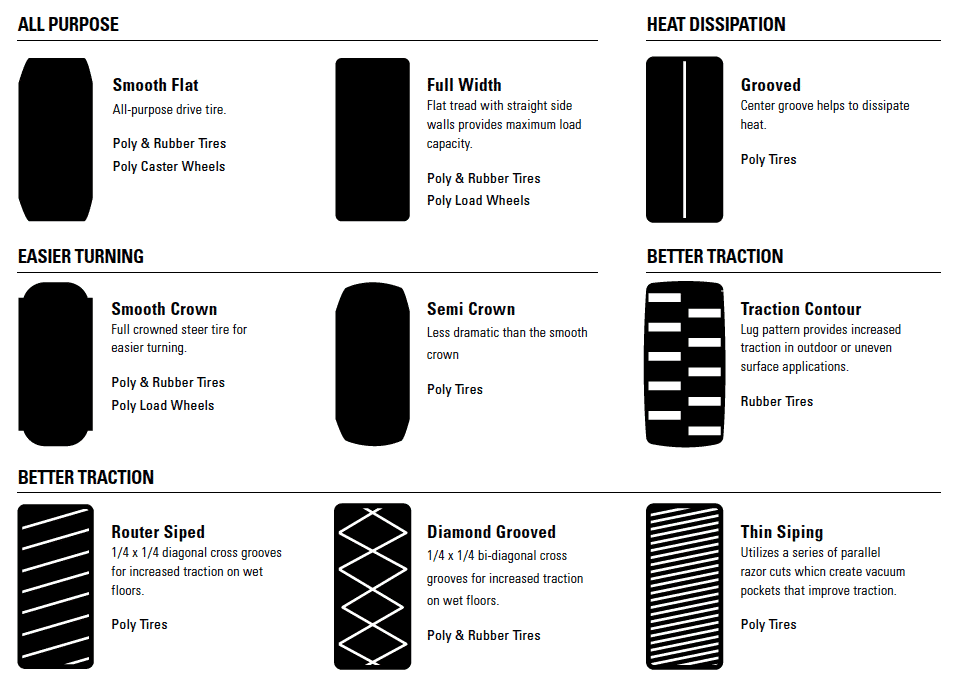Choosing the Right Forklift Tire for Your Operation
To keep your forklifts running and your operators productive, you’ve got to make sure you keep your equipment well maintained. That goes for the tires powering your lift trucks, too. If you don’t check and replace worn tires, you risk:
- Damage to your equipment or workplace
- Costly maintenance and repair costs
- Unsafe operating conditions for your operators
Tires provide a cushion between the forklift and the ground. A smooth ride is more comfortable for the operator. The more tires wear, the less buffer there is and the more shock operators will feel when driving on rough or changing surfaces. Worn, tearing, or chunking of tires can produce operator fatigue and frustration, resulting in mistakes.
Worn tires can also significantly decrease fuel efficiency, costing you more money to operate.
Choosing the Right Type of Forklift Tires
Choosing the right type of forklift tire can keep your operation safe and productive. So, what type of forklift tire do you need? Here are some of the factors you need to take into account, depending on how you use your forklifts:
- Usage levels
- Capacity
- Distance traveled
- Speeds
- Surface conditions
- Moisture levels
- Tread type
- Traction type
- Overheating concerns
- Hardness (Durometer)
- Comfort level
- Marking on non-marking
Choosing the right wheel or tire for your operation requires a number of considerations:
It sounds like a lot to think about, but it doesn’t have to be difficult or time-consuming. The experts at Andersen Material Handling have the expertise, tools, and resources to help you select the best solution for your specific application.
We have a wide variety of tires for every job, including:
Cushion and Pneumatic Forklift Tires
Cushion forklift tires work well on a smooth surface, such as lift truck operations indoors in warehouses with concrete floors. While cushion tires can work outdoors on some surfaces, they are best used for indoor applications. Because cushion forklift tires sit lower to the ground, you can operate with a much tighter turning radius.
Pneumatic forklift tires are a good solution for outdoor use where you have rough or uneven surfaces, or need to travel over different types of surfaces. Pneumatic tires will also have a higher clearance than forklift tires to handle grade changes or rough terrain such as gravel.
Air or Solid Rubber Forklift Tires
For pneumatic tires, you will also need to determine where air or solid rubber tires for lift trucks are your best option. Air pneumatic tires are made of rubber but are filled with air, similar to a car or truck tire. While they have a deep tread and can handle rough surfaces, they are susceptible to punctures. If you are using a lift truck where there is debris, nails or screws, or parts, you will be better off using solid rubber tires. Solid rubber tires won’t be punctured and resist damage from sharp objects.
Solid tires are the most common type of pneumatic tires on the market. They will be slightly more expensive than other options, but pneumatic tires have an exceptionally long lifecycle and stand up to wear and tear better.
Smooth or Traction Forklift Tires
If you are working on dry surfaces, smooth forklift tires will get the job done. If you are working in areas that are susceptible to moisture or wet surfaces, you will do better to opt for traction forklift tires to reduce slippage.
Keep in mind, however, that you do not want to use traction tires on ramps with metal teeth, which can easily damage the tread.
Polyurethane Tires
There are also polyurethane forklift tires, which are lighter weight and work well for specific indoor uses, such as facilities where lift vehicles move at slower speeds. They resist splitting and tearing and are commonly found in warehouses, cold storage facilities, or locations that may see oil or chemical spills.
Choosing the Right Type of Forklift Tire Tread
The right tire tread profile will also make a significant difference in performance depending on application. You can choose all-purpose forklift tires for an all-around solid performance. There are forklift tires designed for easier turning or better traction on wet, outdoor, or uneven surfaces and forklift tires for when heat dissipation is a concern.
All Purpose Forklift Tires
-
- Smooth Flat: Good for all around use with beveled side walls. Comes in poly and rubber tires, poly caster wheels.
- Full Width: Flat treads with straight side walls to support maximum load capacity. Comes in poly and rubber tires, poly lead wheels
For Easier Turning
-
- Smooth Crown: Full-crowned steer tire allows for easier turning. Comes in poly and rubber tires, poly lead wheels.
-
- Semi Crown: Side walls are less dramatic than smooth crown tires, but offer good maneuverability. Comes in poly tires.
For Better Traction
-
- Router Siped: Features ¼ x ¼ diagonal cross grooves to provide increased traction for wet surfaces. Comes in poly tires.
- Diamond Grooved: Features ¼ x ¼ bi-diagonal cross grooves in a diamond shape to provide improved traction on wet surfaces. Comes in poly and rubber tires.
- Thin Siping: A series of parallel razor cuts to create vacuum pockets for traction on wet surfaces. Comes in poly tires.
- Traction Contour: Lug patterns offset on the tire’s surface to provide enhanced traction for outdoor or uneven surface applications. Comes in rubber tires.
For Heat Dissipation
-
- Grooved: A center groove channels heat and aids in dissipation. Comes in poly tires.
Is It Time to Replace My Forklift Tires?
When forklifts are out of service for any reason, it can result in costly downtime. While most companies have the forklift equipment on regular maintenance schedules to keep them operating properly, forklift tires are sometimes overlooked — especially if the forklift itself is running fine.
However, forklifts can be dangerous machines. There are more than 7,200 forklift accidents each year and 85 forklift-related deaths, according to the National Safety Council (NSC). That means one person dies, on average, every four days in the U.S. due to an accident involving a forklift. As such, you need to take every safety precaution you can to protect your workers and your equipment. That includes maintaining and replacing your tires before they cause problems.
You should make regular inspections of your tires as part of your maintenance and safety check procedures. You want to make sure they are in good condition and wearing evenly. You should also ensure they are inflated to the proper air pressure to maximize performance and minimize wear.
Warning Signs of Forklift Tire Fatigue
If you see any of these warning signs, it may be time to replace your forklift tires.
- Chunking of tires or pieces falling off
- Tires that are tearing or cracking
- Flat spots on the tire’s surface
- Tires reaching the 50% wear line
- Less than one inch between lettering and tire tops
Pneumatic forklift tires often have a wear band or wear rings. When this ring is exposed, it’s time for a replacement.
You should also check for uneven wear on the tires or uneven wear between the front and rear on both sides of the forklift. Bent rims, poor tire pressure, or misalignment can shorten the tire’s lifespan.
When it’s time to replace your forklift tires, always replace at least both tires on the same axle for safety reasons. Mismatched tires can lead to stability issues and result in injury. Experts recommend you change all four tires on a cushion forklift at the same time for maximum protection.
Get the Right Forklift Tires from Andersen Material Handling
No matter what type of forklift tire you need, Andersen Material Handling has the tires you need. Our parts experts will find the right one for you. Contact us today and let us go to work for you!


